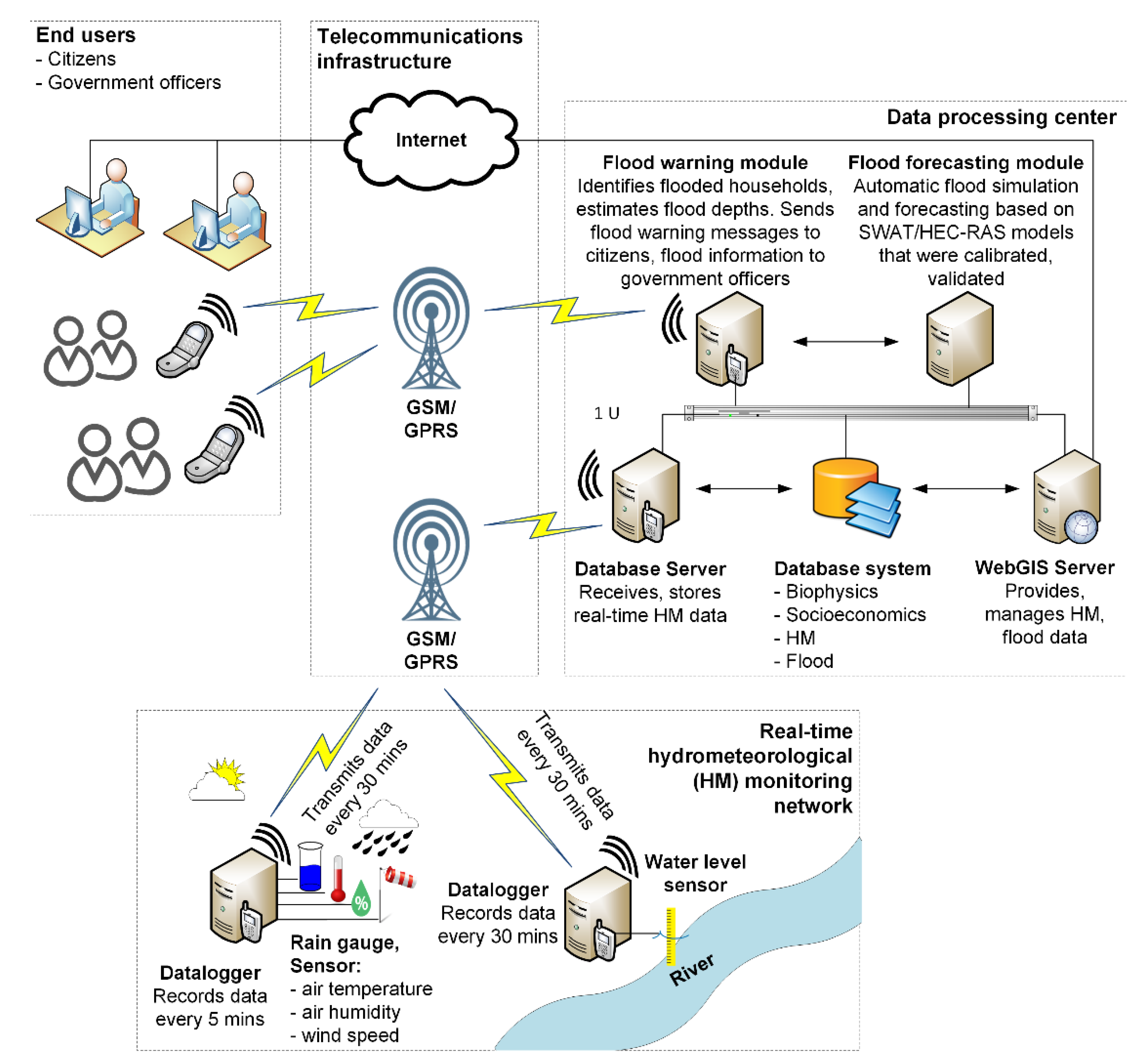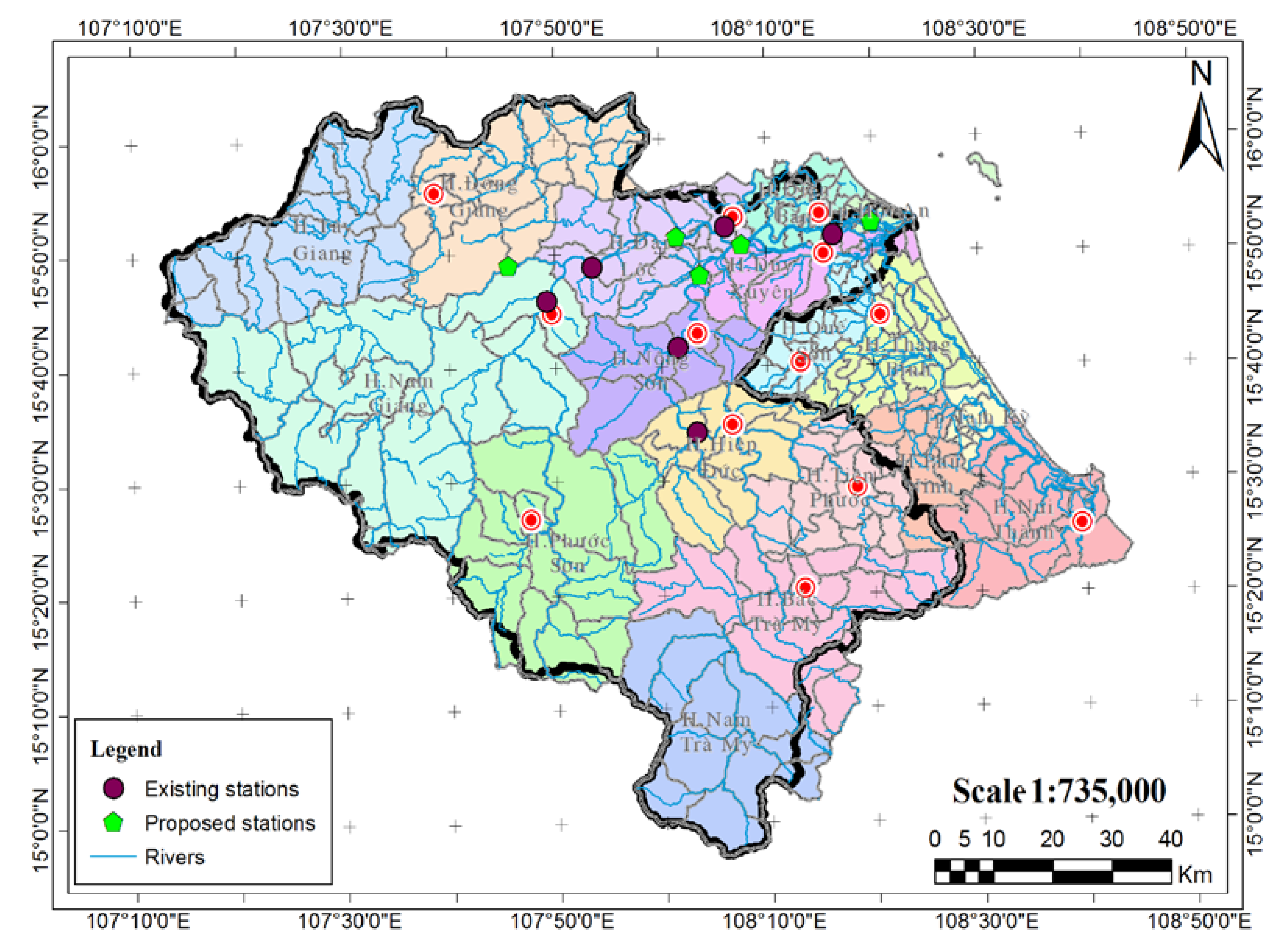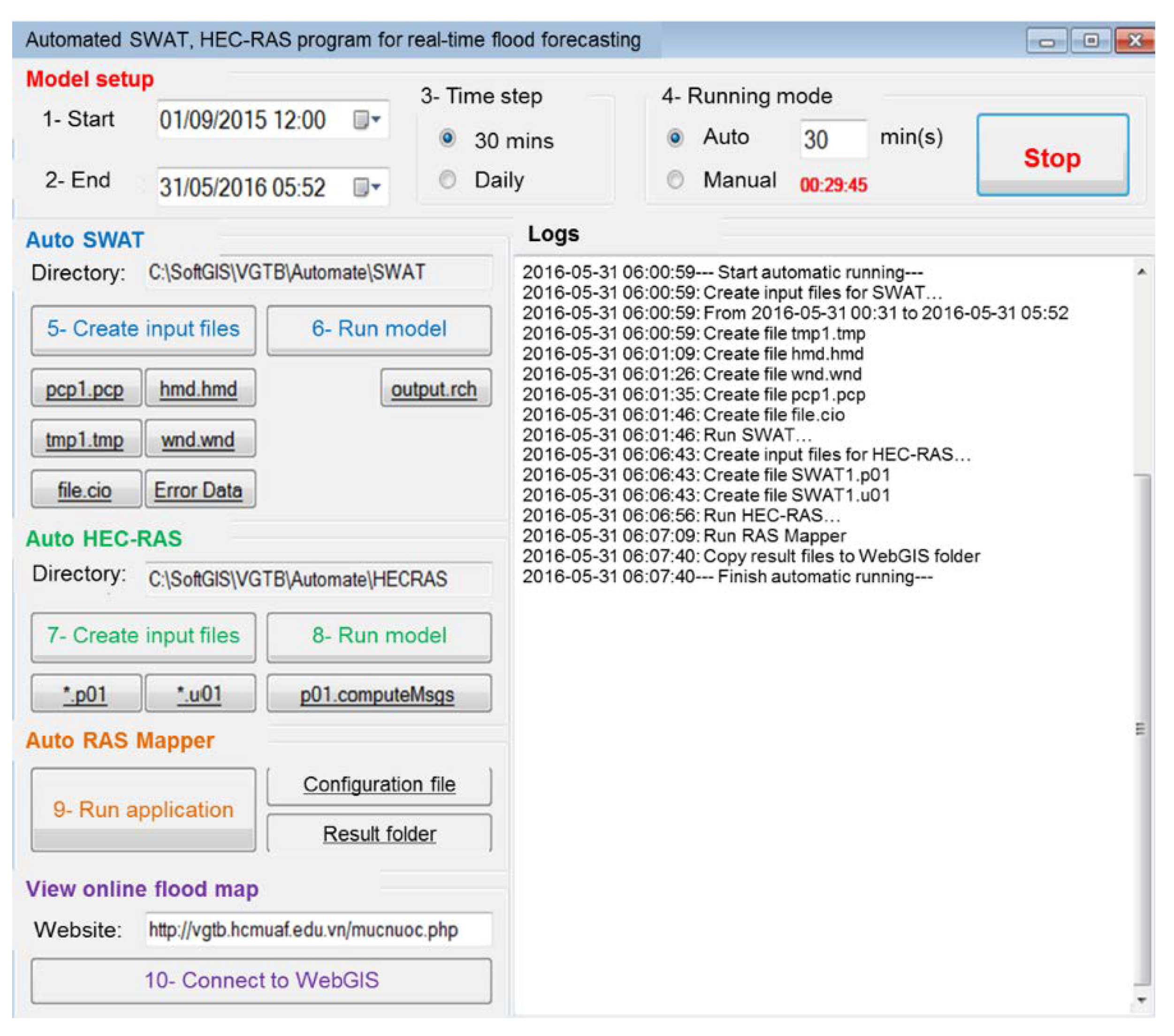Development of a Spatial Decision Support System for Real-Time Flood Early Warning in the Vu Gia-Thu Bon River Basin, Quang Nam Province, Vietnam
Abstract
:1. Introduction
2. Study Area
3. Methodology
3.1. Meteorological Network
3.2. Hydrological Network
3.3. SWAT Model
3.3.1. Overview of SWAT Input/Output Files
3.3.2. Overview of HEC–RAS Input/Output Files
3.3.3. Automated Procedure for SWAT Model
3.3.4. Writing SWAT Input Files
3.3.5. Automated Procedure for the HEC–RAS Model
3.3.6. Writing HEC–RAS Input Files
3.3.7. Executing the HEC–RAS Model
3.3.8. Visualizing the Online Floodplain Map
4. Results and Discussion
4.1. Automated SWAT and HEC–RAS Module for Real-Time Flood Forecasting
4.2. Automated Floodplain Mapping in the Flood Season of 2015
4.3. Module SMS
5. Conclusions
Author Contributions
Funding
Acknowledgments
Conflicts of Interest
References
- Kreft, S.; Eckstein, D.; Melchior, I. Global Climate Risk Index 2017: Who Suffers Most from Extreme Weather Events? Weather-Related Loss Events in 2015 and 1996 to 2015; Germanwatch: Bonn, Germany, 2016. [Google Scholar]
- Tri, O.D.B. A Spatial Decision Support System for Flood Hazard in Quang Nam Province, Vietnam. Ph.D. Thesis, Lincoln University, Lincoln, PA, USA, 2017. [Google Scholar]
- World Bank. Economics of Adaptation to Climate Change: Vietnam; World Bank: Washington, DC, USA, 2010. [Google Scholar]
- Ranger, N.; Lopez, A. The Role of Climate Change in Urban Flood Risk Management Today; Grantham Research Institute on Climate Change and the Environment, Centre for Climate Change Economics and Policy: London, UK, 2011. [Google Scholar]
- Shaw, S.B.; Riha, S.J. Assessing possible changes in flood frequency due to climate change in mid-sized watersheds in New York State, USA. Hydrol. Process. 2011, 25, 2542–2550. [Google Scholar] [CrossRef]
- Arnell, N.W.; Gosling, S.N. The impacts of climate change on river flood risk at the global scale. Clim. Change 2016, 134, 387–401. [Google Scholar] [CrossRef] [Green Version]
- Quang Nam Steering Committee for Storm and Flood Prevention and Control. Impact Assessment of Hydropower Infrastructures on Agriculture and Rural Areas in Quang Nam Province; Quang Nam Steering Committee for Storm and Flood Prevention and Control: Tam Ky, Vietnam, 2010. [Google Scholar]
- An, N.L.; Hoa, N.N. Research on flood forecasting in Vu Gia—Thu Bon river basin. J. Water Resour. Environ. Eng. 2013, 43, 118–124. [Google Scholar]
- Brunner, G.W. HEC-RAS River Analysis System User’s Manual Version 5.0, US Army Corps of Engineers; Hydrologic Engineering Center: Davis, CA, USA, 2016.
- Divac, D.; Milivojević, N.; Grujović, N.; Stojanović, B.; Simić, Z. A procedure for state updating of SWAT-based distributed hydrological model for operational runoff forecasting. J. Serbian Soc. Comput. Mech. 2009, 3, 298–326. [Google Scholar]
- Santillan, J.R.; Paringit, E.C.; Ramos, R.V.; Mendoza, J.R.T.; Española, N.C.; Alconis, J. Development of a HEC RAS Model for Near-Real Time Flood Extent Monitoring in Marikina River, Philippines. In Proceedings of the 1st Philippine Geomatics Symposium (PhilGEOS 2012), Quezon City, Philippines, 22–23 November 2012. [Google Scholar]
- Siqueira, V.A.; Sorribas, M.V.; Bravo, J.M.; Collischonn, W.; Lisboa, A.M.V.; Trinidad, G.G.V. Real-time updating of HEC-RAS model for streamflow forecasting using an optimization algorithm. RBRH 2016, 21, 855–870. [Google Scholar] [CrossRef] [Green Version]
- Leon, A.S.; Goodell, C. Controlling Hec-Ras using Matlab. Environ. Modell. Softw. 2016, 84, 339–348. [Google Scholar] [CrossRef] [Green Version]
- Tiwary, N.K. Real Time Flood Forecasting and Flood Inundation Mapping for Bagmati River System of Bihar, India. Ph.D Thesis, Indian Institute of Technology Delhi, Delhi, India, 2016. [Google Scholar]
- Son, N.H. Flood Modeling for the Vu Gia—Thu Bon River, Central Vietnam. Master’s Thesis, Asian Institute of Technology, Khlong Nueng, Thailand, 2006. [Google Scholar]
- Son, N.H. Study on the application of flood forecasting model for Vu Gia-Thu Bon river. J. Water Resour. Environ. Eng. 2013, 43, 118–124. (In Vietnamese) [Google Scholar]
- Tinh, T.V. Flood Mapping in Downstream of Vu Gia—Thu Bon River Basin. Master’s Thesis, Vietnam National University, Hanoi, Vietnam, 2013. [Google Scholar]
- Thien, N.H. Application of MIKE11 and HEC-RAS Models to Flood Problems on the A Vuong River. Master‘s Thesis, Nice-Sophia Antipolis University, Nice, France, 2011. [Google Scholar]
- Nga, T.T. Establishing a flood simulation model for reservoir operation in the Vu Gia—Thu Bon river during the flood season. J. Water Resour. Environ. Eng. 2013, 42, 18–24. (In Vietnamese) [Google Scholar]
- Mai, D.T. Application of WETSPA and HEC-RAS Models to Simulating and Predicting Floods in Vu Gia—Thu Bon River System; Ministerial-level project: Hanoi, Vietnam, 2009. [Google Scholar]
- Loi, N.K.; Liem, N.D.; Tu, L.H.; Hong, N.T.; Truong, C.D.; Tram, V.N.Q.; Nhat, T.T.; Anh, T.N.; Jeong, J. Automated procedure of real-time flood forecasting in Vu Gia–Thu Bon river basin, Vietnam by integrating SWAT and HEC-RAS models. J. Water Clim. Change 2019, 10, 535–545. [Google Scholar] [CrossRef]
- Thi Hong, N.; Truc, T.; Thi, P.; Duy Liem, N.; Kim Loi, N. Optimal Selection of Number and Location of Meteo-Hydrological Monitoring Networks on Vu Gia–Thu Bon River Basin using GIS. Int. J. Adv. Sci. Eng. Inf. Technol. 2016, 6, 324–328. [Google Scholar] [CrossRef]
- Goodell, C. Breaking the HEC-RAS Code: A User’s Guide to Automating HEC-RAS; H2ls: Portland, OR, USA, 2014. [Google Scholar]
- Neitsch, S.L.; Arnold, J.G.; Kiniry, J.R.; Williams, J.R. Soil and Water Assessment Tool: Theoretical Documentation, Version 2009; Texas Water Resources Institute: College Station, TX, USA, 2011. [Google Scholar]

















© 2020 by the authors. Licensee MDPI, Basel, Switzerland. This article is an open access article distributed under the terms and conditions of the Creative Commons Attribution (CC BY) license (http://creativecommons.org/licenses/by/4.0/).
Share and Cite
Nguyen, H.T.; Duong, T.Q.; Nguyen, L.D.; Vo, T.Q.N.; Tran, N.T.; Dang, P.D.N.; Nguyen, L.D.; Dang, C.K.; Nguyen, L.K. Development of a Spatial Decision Support System for Real-Time Flood Early Warning in the Vu Gia-Thu Bon River Basin, Quang Nam Province, Vietnam. Sensors 2020, 20, 1667. https://doi.org/10.3390/s20061667
Nguyen HT, Duong TQ, Nguyen LD, Vo TQN, Tran NT, Dang PDN, Nguyen LD, Dang CK, Nguyen LK. Development of a Spatial Decision Support System for Real-Time Flood Early Warning in the Vu Gia-Thu Bon River Basin, Quang Nam Province, Vietnam. Sensors. 2020; 20(6):1667. https://doi.org/10.3390/s20061667
Chicago/Turabian StyleNguyen, Hong T., Trung Q. Duong, Liem D. Nguyen, Tram Q.N. Vo, Nhat T. Tran, Phuong D.N. Dang, Long D. Nguyen, Cuong K. Dang, and Loi K. Nguyen. 2020. "Development of a Spatial Decision Support System for Real-Time Flood Early Warning in the Vu Gia-Thu Bon River Basin, Quang Nam Province, Vietnam" Sensors 20, no. 6: 1667. https://doi.org/10.3390/s20061667
APA StyleNguyen, H. T., Duong, T. Q., Nguyen, L. D., Vo, T. Q. N., Tran, N. T., Dang, P. D. N., Nguyen, L. D., Dang, C. K., & Nguyen, L. K. (2020). Development of a Spatial Decision Support System for Real-Time Flood Early Warning in the Vu Gia-Thu Bon River Basin, Quang Nam Province, Vietnam. Sensors, 20(6), 1667. https://doi.org/10.3390/s20061667





